MA HRM Dissertation: Impact of Whistleblowing on NHS Organisation
VerifiedAdded on 2023/06/11
|61
|18705
|265
Thesis and Dissertation
AI Summary
This dissertation explores the impact of whistleblowing on organisational learning within the National Health Service (NHS). It begins by introducing the concept of whistleblowing, highlighting its controversial nature and the potential sacrifices faced by whistleblowers. The research delves into the background of whistleblowing within the NHS context, discussing relevant legislation and the importance of protecting employee rights. It examines the rationale for the research, focusing on the need to understand the causes and effects of whistleblowing on employees and the organization. The study uses secondary analysis to investigate the research topic. The findings suggest that despite efforts to encourage employees to raise concerns, healthcare systems internationally struggle to involve employees, and that concerns are often ignored. The dissertation concludes with recommendations, including training, financial incentives, and endorsement from top management, to improve the effectiveness of whistleblowing mechanisms within the NHS. Desklib provides access to similar dissertations and study tools for students.
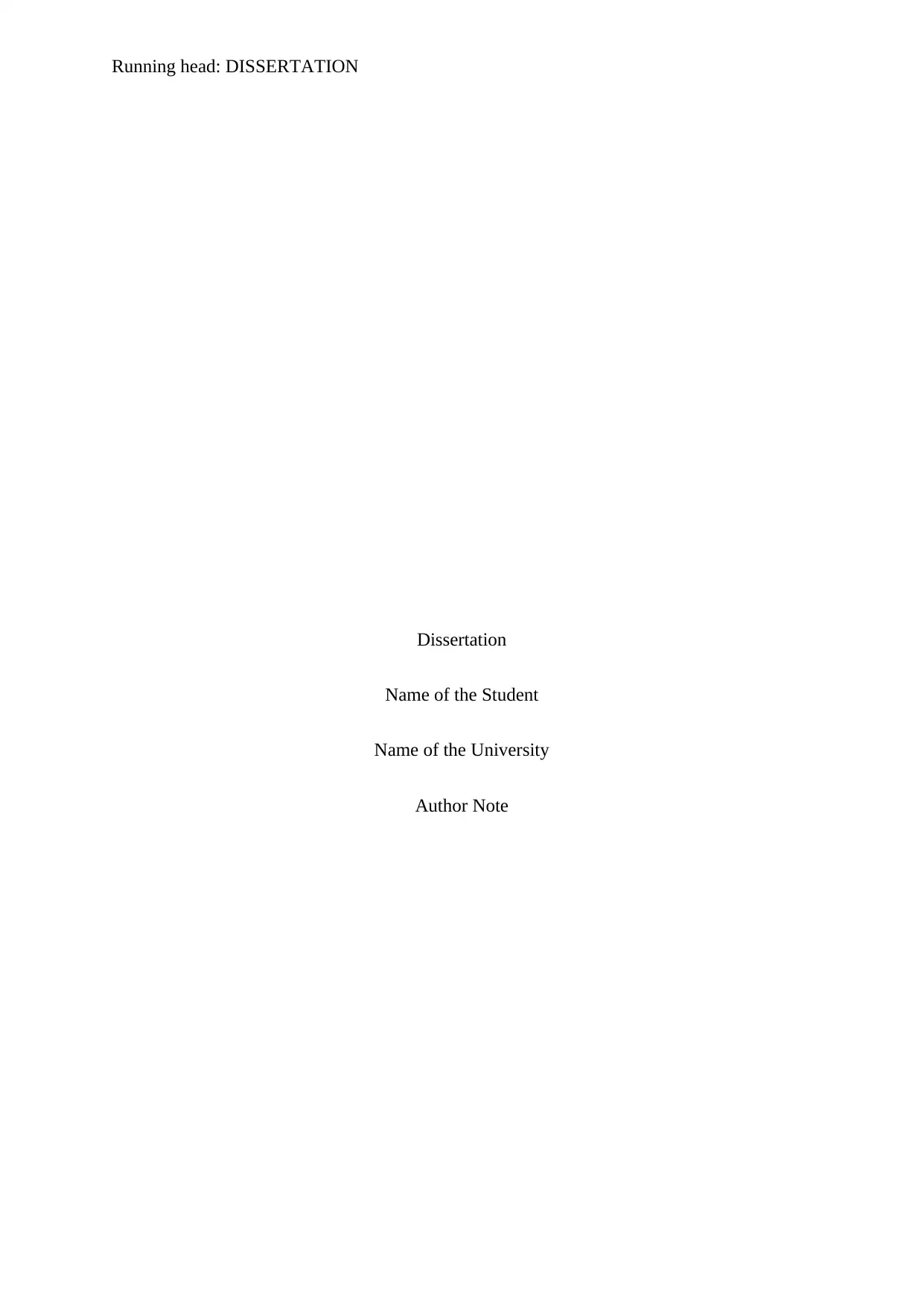
Running head: DISSERTATION
Dissertation
Name of the Student
Name of the University
Author Note
Dissertation
Name of the Student
Name of the University
Author Note
Paraphrase This Document
Need a fresh take? Get an instant paraphrase of this document with our AI Paraphraser
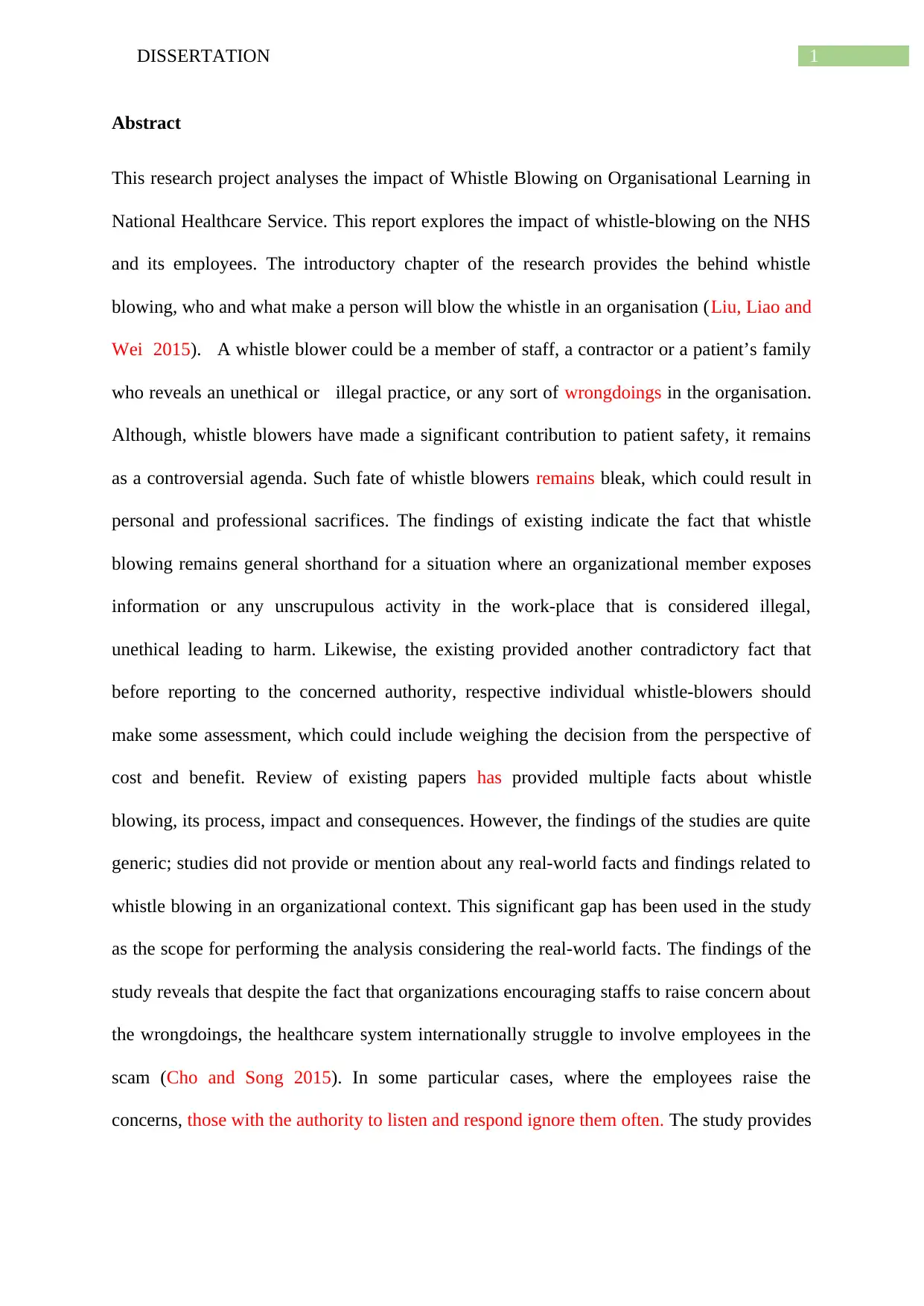
1DISSERTATION
Abstract
This research project analyses the impact of Whistle Blowing on Organisational Learning in
National Healthcare Service. This report explores the impact of whistle-blowing on the NHS
and its employees. The introductory chapter of the research provides the behind whistle
blowing, who and what make a person will blow the whistle in an organisation (Liu, Liao and
Wei 2015). A whistle blower could be a member of staff, a contractor or a patient’s family
who reveals an unethical or illegal practice, or any sort of wrongdoings in the organisation.
Although, whistle blowers have made a significant contribution to patient safety, it remains
as a controversial agenda. Such fate of whistle blowers remains bleak, which could result in
personal and professional sacrifices. The findings of existing indicate the fact that whistle
blowing remains general shorthand for a situation where an organizational member exposes
information or any unscrupulous activity in the work-place that is considered illegal,
unethical leading to harm. Likewise, the existing provided another contradictory fact that
before reporting to the concerned authority, respective individual whistle-blowers should
make some assessment, which could include weighing the decision from the perspective of
cost and benefit. Review of existing papers has provided multiple facts about whistle
blowing, its process, impact and consequences. However, the findings of the studies are quite
generic; studies did not provide or mention about any real-world facts and findings related to
whistle blowing in an organizational context. This significant gap has been used in the study
as the scope for performing the analysis considering the real-world facts. The findings of the
study reveals that despite the fact that organizations encouraging staffs to raise concern about
the wrongdoings, the healthcare system internationally struggle to involve employees in the
scam (Cho and Song 2015). In some particular cases, where the employees raise the
concerns, those with the authority to listen and respond ignore them often. The study provides
Abstract
This research project analyses the impact of Whistle Blowing on Organisational Learning in
National Healthcare Service. This report explores the impact of whistle-blowing on the NHS
and its employees. The introductory chapter of the research provides the behind whistle
blowing, who and what make a person will blow the whistle in an organisation (Liu, Liao and
Wei 2015). A whistle blower could be a member of staff, a contractor or a patient’s family
who reveals an unethical or illegal practice, or any sort of wrongdoings in the organisation.
Although, whistle blowers have made a significant contribution to patient safety, it remains
as a controversial agenda. Such fate of whistle blowers remains bleak, which could result in
personal and professional sacrifices. The findings of existing indicate the fact that whistle
blowing remains general shorthand for a situation where an organizational member exposes
information or any unscrupulous activity in the work-place that is considered illegal,
unethical leading to harm. Likewise, the existing provided another contradictory fact that
before reporting to the concerned authority, respective individual whistle-blowers should
make some assessment, which could include weighing the decision from the perspective of
cost and benefit. Review of existing papers has provided multiple facts about whistle
blowing, its process, impact and consequences. However, the findings of the studies are quite
generic; studies did not provide or mention about any real-world facts and findings related to
whistle blowing in an organizational context. This significant gap has been used in the study
as the scope for performing the analysis considering the real-world facts. The findings of the
study reveals that despite the fact that organizations encouraging staffs to raise concern about
the wrongdoings, the healthcare system internationally struggle to involve employees in the
scam (Cho and Song 2015). In some particular cases, where the employees raise the
concerns, those with the authority to listen and respond ignore them often. The study provides
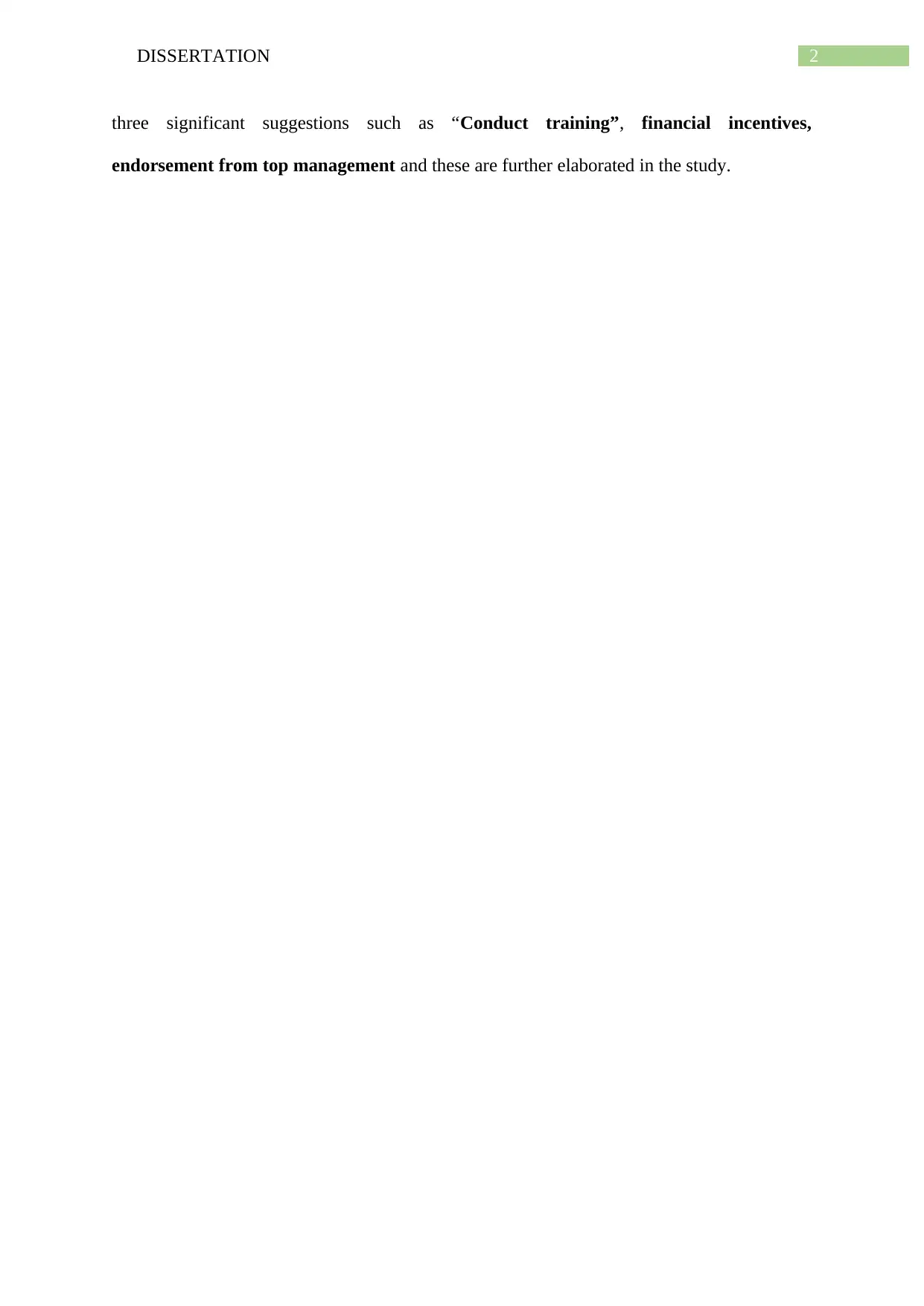
2DISSERTATION
three significant suggestions such as “Conduct training”, financial incentives,
endorsement from top management and these are further elaborated in the study.
three significant suggestions such as “Conduct training”, financial incentives,
endorsement from top management and these are further elaborated in the study.
⊘ This is a preview!⊘
Do you want full access?
Subscribe today to unlock all pages.

Trusted by 1+ million students worldwide
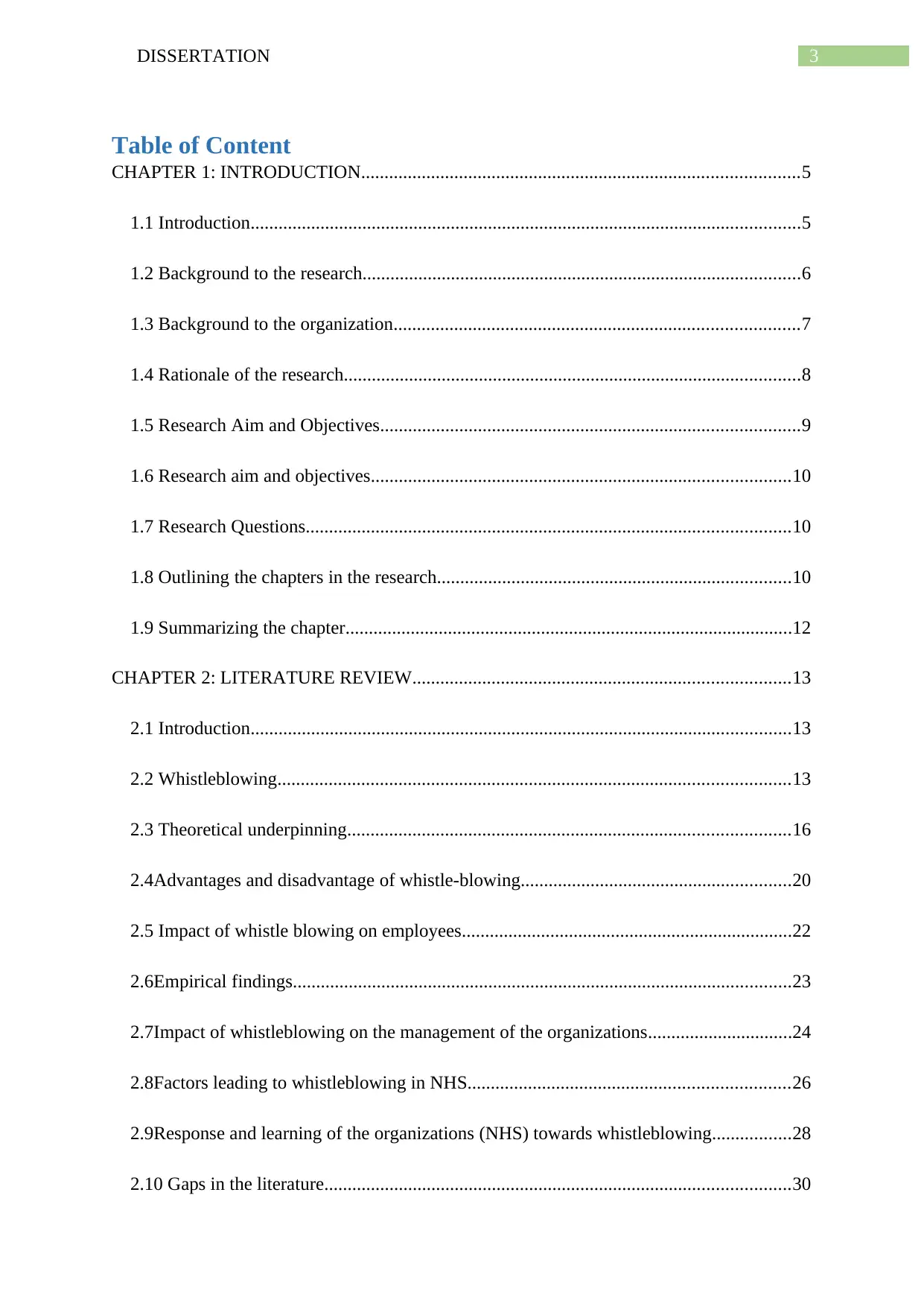
3DISSERTATION
Table of Content
CHAPTER 1: INTRODUCTION..............................................................................................5
1.1 Introduction......................................................................................................................5
1.2 Background to the research..............................................................................................6
1.3 Background to the organization.......................................................................................7
1.4 Rationale of the research..................................................................................................8
1.5 Research Aim and Objectives..........................................................................................9
1.6 Research aim and objectives..........................................................................................10
1.7 Research Questions........................................................................................................10
1.8 Outlining the chapters in the research............................................................................10
1.9 Summarizing the chapter................................................................................................12
CHAPTER 2: LITERATURE REVIEW.................................................................................13
2.1 Introduction....................................................................................................................13
2.2 Whistleblowing..............................................................................................................13
2.3 Theoretical underpinning...............................................................................................16
2.4Advantages and disadvantage of whistle-blowing..........................................................20
2.5 Impact of whistle blowing on employees.......................................................................22
2.6Empirical findings...........................................................................................................23
2.7Impact of whistleblowing on the management of the organizations...............................24
2.8Factors leading to whistleblowing in NHS.....................................................................26
2.9Response and learning of the organizations (NHS) towards whistleblowing.................28
2.10 Gaps in the literature....................................................................................................30
Table of Content
CHAPTER 1: INTRODUCTION..............................................................................................5
1.1 Introduction......................................................................................................................5
1.2 Background to the research..............................................................................................6
1.3 Background to the organization.......................................................................................7
1.4 Rationale of the research..................................................................................................8
1.5 Research Aim and Objectives..........................................................................................9
1.6 Research aim and objectives..........................................................................................10
1.7 Research Questions........................................................................................................10
1.8 Outlining the chapters in the research............................................................................10
1.9 Summarizing the chapter................................................................................................12
CHAPTER 2: LITERATURE REVIEW.................................................................................13
2.1 Introduction....................................................................................................................13
2.2 Whistleblowing..............................................................................................................13
2.3 Theoretical underpinning...............................................................................................16
2.4Advantages and disadvantage of whistle-blowing..........................................................20
2.5 Impact of whistle blowing on employees.......................................................................22
2.6Empirical findings...........................................................................................................23
2.7Impact of whistleblowing on the management of the organizations...............................24
2.8Factors leading to whistleblowing in NHS.....................................................................26
2.9Response and learning of the organizations (NHS) towards whistleblowing.................28
2.10 Gaps in the literature....................................................................................................30
Paraphrase This Document
Need a fresh take? Get an instant paraphrase of this document with our AI Paraphraser
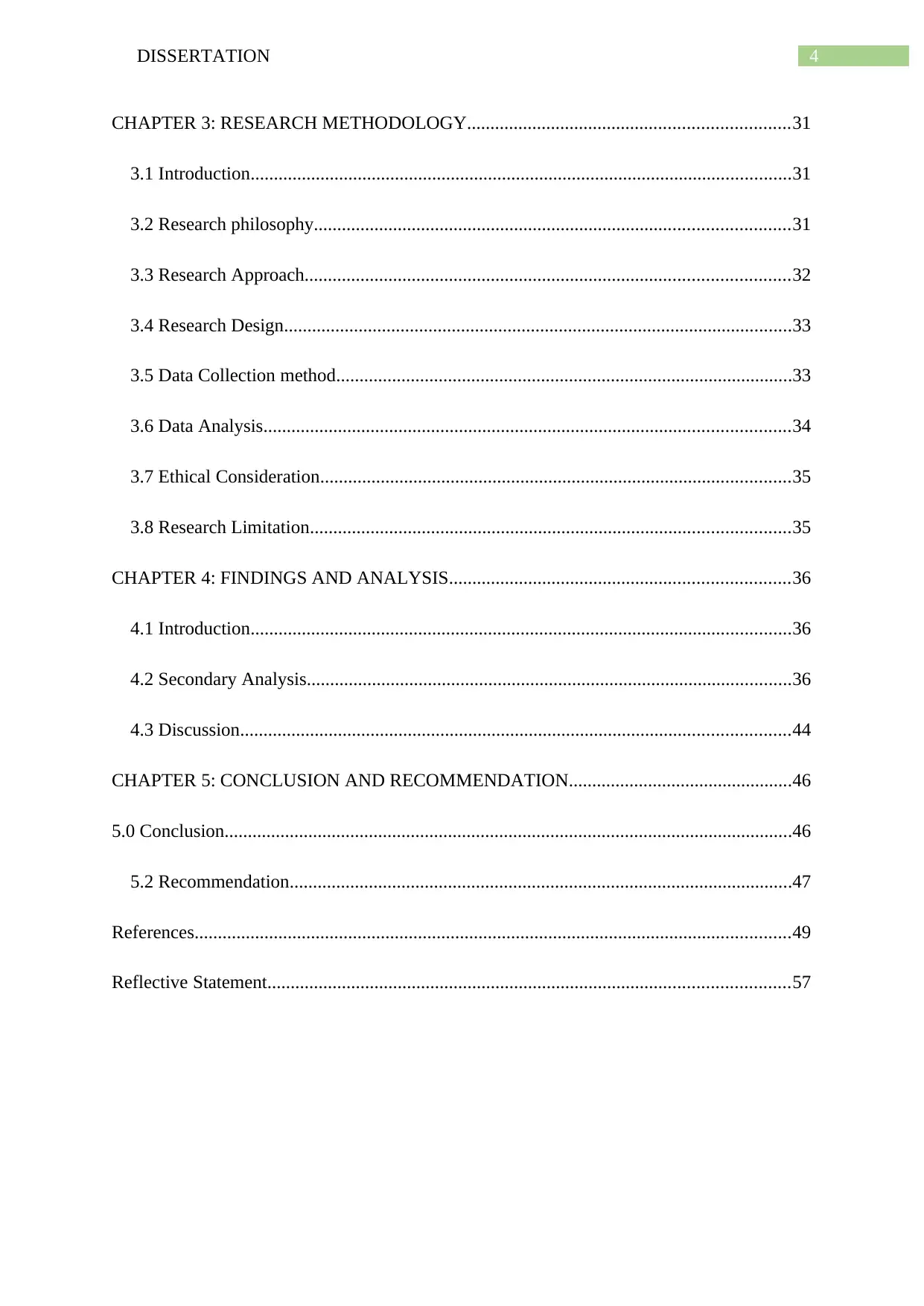
4DISSERTATION
CHAPTER 3: RESEARCH METHODOLOGY.....................................................................31
3.1 Introduction....................................................................................................................31
3.2 Research philosophy......................................................................................................31
3.3 Research Approach........................................................................................................32
3.4 Research Design.............................................................................................................33
3.5 Data Collection method..................................................................................................33
3.6 Data Analysis.................................................................................................................34
3.7 Ethical Consideration.....................................................................................................35
3.8 Research Limitation.......................................................................................................35
CHAPTER 4: FINDINGS AND ANALYSIS.........................................................................36
4.1 Introduction....................................................................................................................36
4.2 Secondary Analysis........................................................................................................36
4.3 Discussion......................................................................................................................44
CHAPTER 5: CONCLUSION AND RECOMMENDATION................................................46
5.0 Conclusion..........................................................................................................................46
5.2 Recommendation............................................................................................................47
References................................................................................................................................49
Reflective Statement................................................................................................................57
CHAPTER 3: RESEARCH METHODOLOGY.....................................................................31
3.1 Introduction....................................................................................................................31
3.2 Research philosophy......................................................................................................31
3.3 Research Approach........................................................................................................32
3.4 Research Design.............................................................................................................33
3.5 Data Collection method..................................................................................................33
3.6 Data Analysis.................................................................................................................34
3.7 Ethical Consideration.....................................................................................................35
3.8 Research Limitation.......................................................................................................35
CHAPTER 4: FINDINGS AND ANALYSIS.........................................................................36
4.1 Introduction....................................................................................................................36
4.2 Secondary Analysis........................................................................................................36
4.3 Discussion......................................................................................................................44
CHAPTER 5: CONCLUSION AND RECOMMENDATION................................................46
5.0 Conclusion..........................................................................................................................46
5.2 Recommendation............................................................................................................47
References................................................................................................................................49
Reflective Statement................................................................................................................57
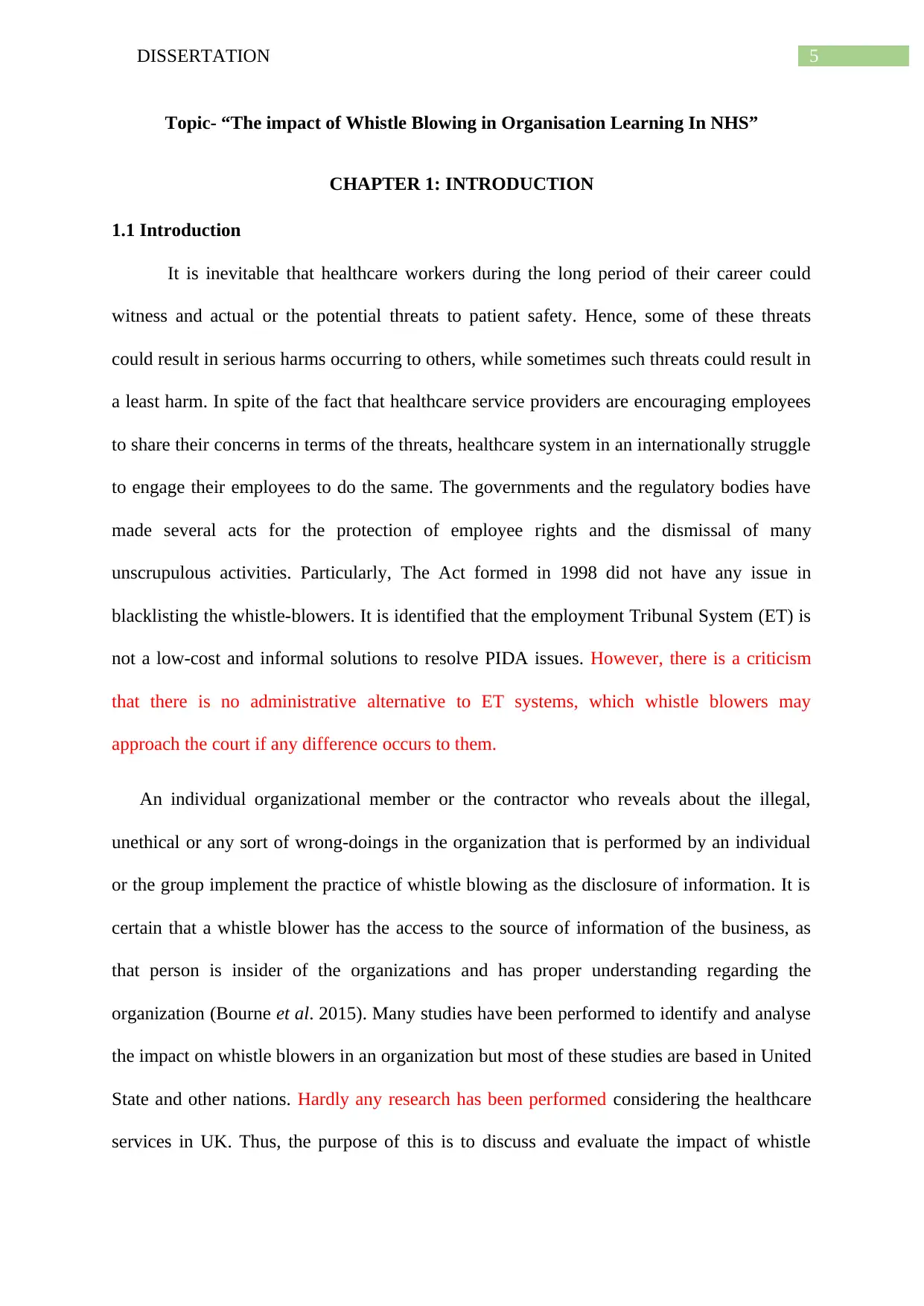
5DISSERTATION
Topic- “The impact of Whistle Blowing in Organisation Learning In NHS”
CHAPTER 1: INTRODUCTION
1.1 Introduction
It is inevitable that healthcare workers during the long period of their career could
witness and actual or the potential threats to patient safety. Hence, some of these threats
could result in serious harms occurring to others, while sometimes such threats could result in
a least harm. In spite of the fact that healthcare service providers are encouraging employees
to share their concerns in terms of the threats, healthcare system in an internationally struggle
to engage their employees to do the same. The governments and the regulatory bodies have
made several acts for the protection of employee rights and the dismissal of many
unscrupulous activities. Particularly, The Act formed in 1998 did not have any issue in
blacklisting the whistle-blowers. It is identified that the employment Tribunal System (ET) is
not a low-cost and informal solutions to resolve PIDA issues. However, there is a criticism
that there is no administrative alternative to ET systems, which whistle blowers may
approach the court if any difference occurs to them.
An individual organizational member or the contractor who reveals about the illegal,
unethical or any sort of wrong-doings in the organization that is performed by an individual
or the group implement the practice of whistle blowing as the disclosure of information. It is
certain that a whistle blower has the access to the source of information of the business, as
that person is insider of the organizations and has proper understanding regarding the
organization (Bourne et al. 2015). Many studies have been performed to identify and analyse
the impact on whistle blowers in an organization but most of these studies are based in United
State and other nations. Hardly any research has been performed considering the healthcare
services in UK. Thus, the purpose of this is to discuss and evaluate the impact of whistle
Topic- “The impact of Whistle Blowing in Organisation Learning In NHS”
CHAPTER 1: INTRODUCTION
1.1 Introduction
It is inevitable that healthcare workers during the long period of their career could
witness and actual or the potential threats to patient safety. Hence, some of these threats
could result in serious harms occurring to others, while sometimes such threats could result in
a least harm. In spite of the fact that healthcare service providers are encouraging employees
to share their concerns in terms of the threats, healthcare system in an internationally struggle
to engage their employees to do the same. The governments and the regulatory bodies have
made several acts for the protection of employee rights and the dismissal of many
unscrupulous activities. Particularly, The Act formed in 1998 did not have any issue in
blacklisting the whistle-blowers. It is identified that the employment Tribunal System (ET) is
not a low-cost and informal solutions to resolve PIDA issues. However, there is a criticism
that there is no administrative alternative to ET systems, which whistle blowers may
approach the court if any difference occurs to them.
An individual organizational member or the contractor who reveals about the illegal,
unethical or any sort of wrong-doings in the organization that is performed by an individual
or the group implement the practice of whistle blowing as the disclosure of information. It is
certain that a whistle blower has the access to the source of information of the business, as
that person is insider of the organizations and has proper understanding regarding the
organization (Bourne et al. 2015). Many studies have been performed to identify and analyse
the impact on whistle blowers in an organization but most of these studies are based in United
State and other nations. Hardly any research has been performed considering the healthcare
services in UK. Thus, the purpose of this is to discuss and evaluate the impact of whistle
⊘ This is a preview!⊘
Do you want full access?
Subscribe today to unlock all pages.

Trusted by 1+ million students worldwide
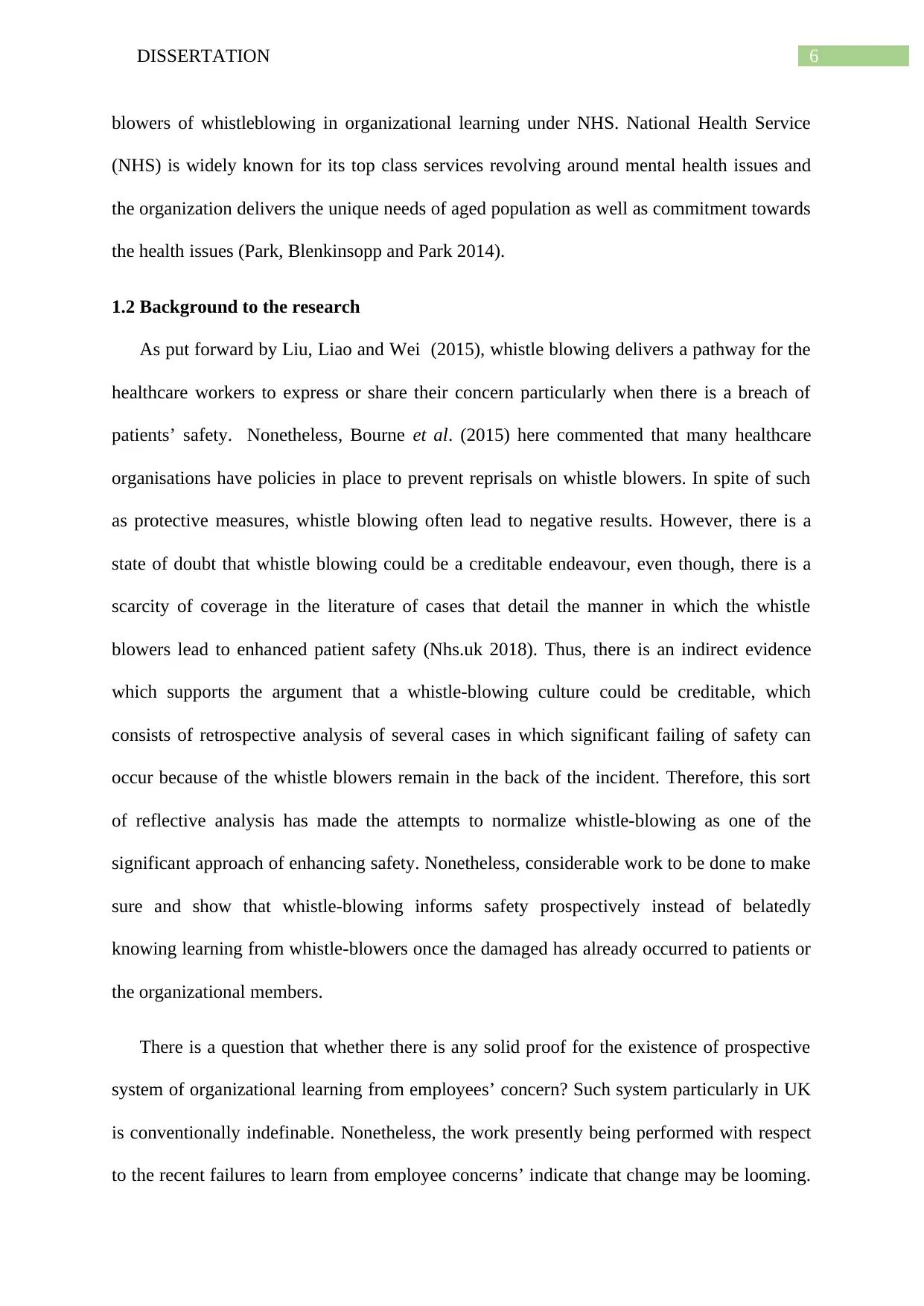
6DISSERTATION
blowers of whistleblowing in organizational learning under NHS. National Health Service
(NHS) is widely known for its top class services revolving around mental health issues and
the organization delivers the unique needs of aged population as well as commitment towards
the health issues (Park, Blenkinsopp and Park 2014).
1.2 Background to the research
As put forward by Liu, Liao and Wei (2015), whistle blowing delivers a pathway for the
healthcare workers to express or share their concern particularly when there is a breach of
patients’ safety. Nonetheless, Bourne et al. (2015) here commented that many healthcare
organisations have policies in place to prevent reprisals on whistle blowers. In spite of such
as protective measures, whistle blowing often lead to negative results. However, there is a
state of doubt that whistle blowing could be a creditable endeavour, even though, there is a
scarcity of coverage in the literature of cases that detail the manner in which the whistle
blowers lead to enhanced patient safety (Nhs.uk 2018). Thus, there is an indirect evidence
which supports the argument that a whistle-blowing culture could be creditable, which
consists of retrospective analysis of several cases in which significant failing of safety can
occur because of the whistle blowers remain in the back of the incident. Therefore, this sort
of reflective analysis has made the attempts to normalize whistle-blowing as one of the
significant approach of enhancing safety. Nonetheless, considerable work to be done to make
sure and show that whistle-blowing informs safety prospectively instead of belatedly
knowing learning from whistle-blowers once the damaged has already occurred to patients or
the organizational members.
There is a question that whether there is any solid proof for the existence of prospective
system of organizational learning from employees’ concern? Such system particularly in UK
is conventionally indefinable. Nonetheless, the work presently being performed with respect
to the recent failures to learn from employee concerns’ indicate that change may be looming.
blowers of whistleblowing in organizational learning under NHS. National Health Service
(NHS) is widely known for its top class services revolving around mental health issues and
the organization delivers the unique needs of aged population as well as commitment towards
the health issues (Park, Blenkinsopp and Park 2014).
1.2 Background to the research
As put forward by Liu, Liao and Wei (2015), whistle blowing delivers a pathway for the
healthcare workers to express or share their concern particularly when there is a breach of
patients’ safety. Nonetheless, Bourne et al. (2015) here commented that many healthcare
organisations have policies in place to prevent reprisals on whistle blowers. In spite of such
as protective measures, whistle blowing often lead to negative results. However, there is a
state of doubt that whistle blowing could be a creditable endeavour, even though, there is a
scarcity of coverage in the literature of cases that detail the manner in which the whistle
blowers lead to enhanced patient safety (Nhs.uk 2018). Thus, there is an indirect evidence
which supports the argument that a whistle-blowing culture could be creditable, which
consists of retrospective analysis of several cases in which significant failing of safety can
occur because of the whistle blowers remain in the back of the incident. Therefore, this sort
of reflective analysis has made the attempts to normalize whistle-blowing as one of the
significant approach of enhancing safety. Nonetheless, considerable work to be done to make
sure and show that whistle-blowing informs safety prospectively instead of belatedly
knowing learning from whistle-blowers once the damaged has already occurred to patients or
the organizational members.
There is a question that whether there is any solid proof for the existence of prospective
system of organizational learning from employees’ concern? Such system particularly in UK
is conventionally indefinable. Nonetheless, the work presently being performed with respect
to the recent failures to learn from employee concerns’ indicate that change may be looming.
Paraphrase This Document
Need a fresh take? Get an instant paraphrase of this document with our AI Paraphraser
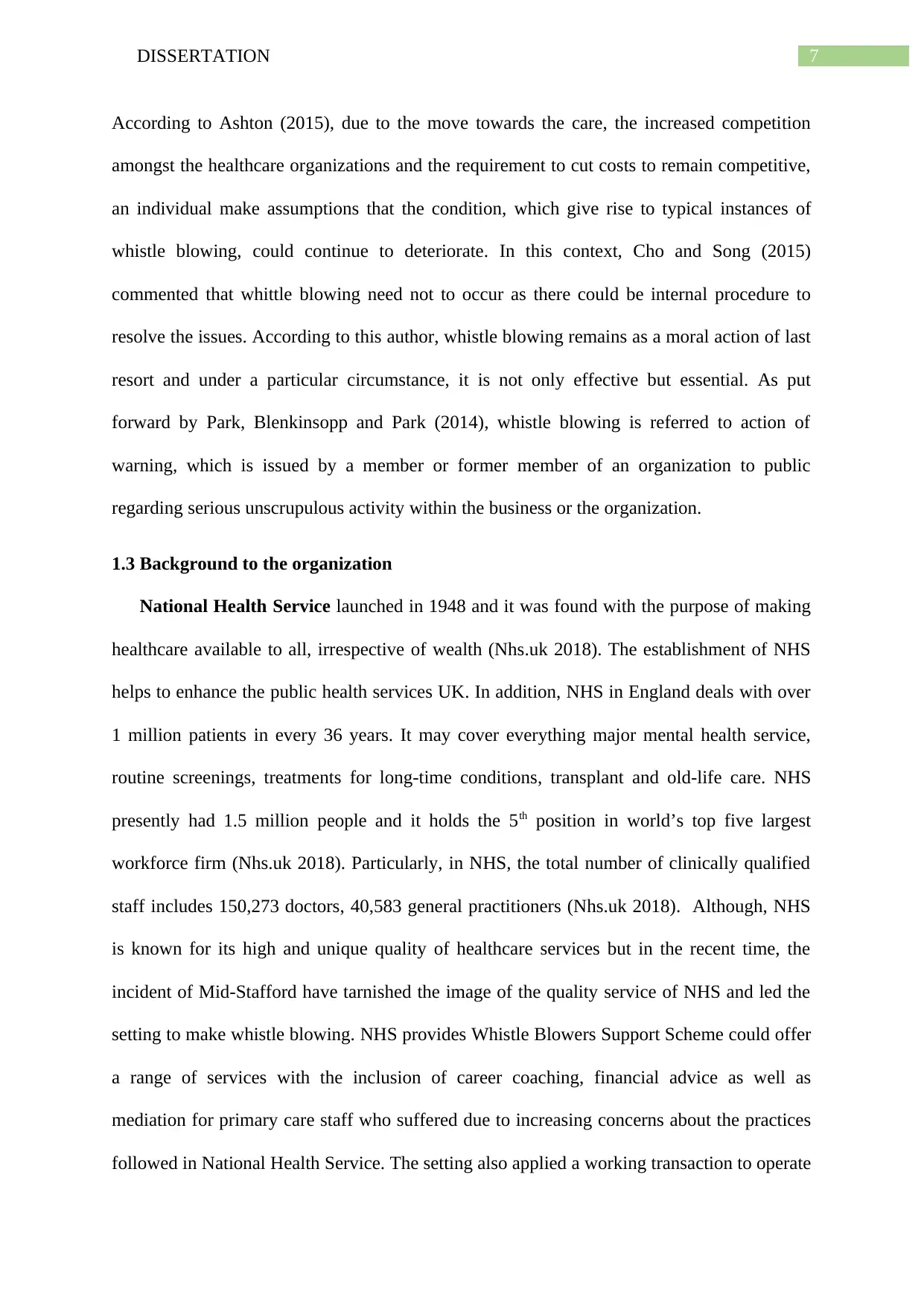
7DISSERTATION
According to Ashton (2015), due to the move towards the care, the increased competition
amongst the healthcare organizations and the requirement to cut costs to remain competitive,
an individual make assumptions that the condition, which give rise to typical instances of
whistle blowing, could continue to deteriorate. In this context, Cho and Song (2015)
commented that whittle blowing need not to occur as there could be internal procedure to
resolve the issues. According to this author, whistle blowing remains as a moral action of last
resort and under a particular circumstance, it is not only effective but essential. As put
forward by Park, Blenkinsopp and Park (2014), whistle blowing is referred to action of
warning, which is issued by a member or former member of an organization to public
regarding serious unscrupulous activity within the business or the organization.
1.3 Background to the organization
National Health Service launched in 1948 and it was found with the purpose of making
healthcare available to all, irrespective of wealth (Nhs.uk 2018). The establishment of NHS
helps to enhance the public health services UK. In addition, NHS in England deals with over
1 million patients in every 36 years. It may cover everything major mental health service,
routine screenings, treatments for long-time conditions, transplant and old-life care. NHS
presently had 1.5 million people and it holds the 5th position in world’s top five largest
workforce firm (Nhs.uk 2018). Particularly, in NHS, the total number of clinically qualified
staff includes 150,273 doctors, 40,583 general practitioners (Nhs.uk 2018). Although, NHS
is known for its high and unique quality of healthcare services but in the recent time, the
incident of Mid-Stafford have tarnished the image of the quality service of NHS and led the
setting to make whistle blowing. NHS provides Whistle Blowers Support Scheme could offer
a range of services with the inclusion of career coaching, financial advice as well as
mediation for primary care staff who suffered due to increasing concerns about the practices
followed in National Health Service. The setting also applied a working transaction to operate
According to Ashton (2015), due to the move towards the care, the increased competition
amongst the healthcare organizations and the requirement to cut costs to remain competitive,
an individual make assumptions that the condition, which give rise to typical instances of
whistle blowing, could continue to deteriorate. In this context, Cho and Song (2015)
commented that whittle blowing need not to occur as there could be internal procedure to
resolve the issues. According to this author, whistle blowing remains as a moral action of last
resort and under a particular circumstance, it is not only effective but essential. As put
forward by Park, Blenkinsopp and Park (2014), whistle blowing is referred to action of
warning, which is issued by a member or former member of an organization to public
regarding serious unscrupulous activity within the business or the organization.
1.3 Background to the organization
National Health Service launched in 1948 and it was found with the purpose of making
healthcare available to all, irrespective of wealth (Nhs.uk 2018). The establishment of NHS
helps to enhance the public health services UK. In addition, NHS in England deals with over
1 million patients in every 36 years. It may cover everything major mental health service,
routine screenings, treatments for long-time conditions, transplant and old-life care. NHS
presently had 1.5 million people and it holds the 5th position in world’s top five largest
workforce firm (Nhs.uk 2018). Particularly, in NHS, the total number of clinically qualified
staff includes 150,273 doctors, 40,583 general practitioners (Nhs.uk 2018). Although, NHS
is known for its high and unique quality of healthcare services but in the recent time, the
incident of Mid-Stafford have tarnished the image of the quality service of NHS and led the
setting to make whistle blowing. NHS provides Whistle Blowers Support Scheme could offer
a range of services with the inclusion of career coaching, financial advice as well as
mediation for primary care staff who suffered due to increasing concerns about the practices
followed in National Health Service. The setting also applied a working transaction to operate
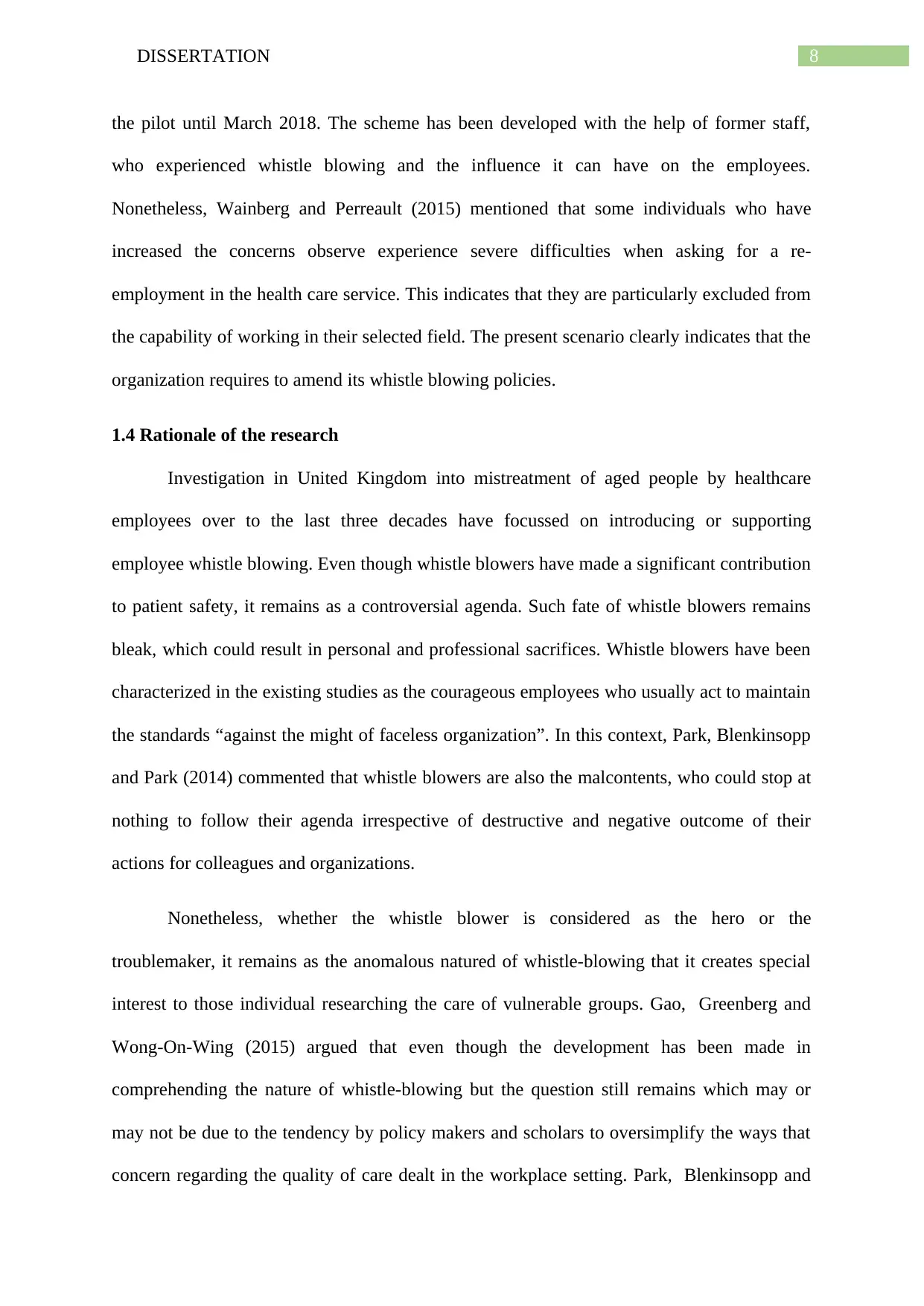
8DISSERTATION
the pilot until March 2018. The scheme has been developed with the help of former staff,
who experienced whistle blowing and the influence it can have on the employees.
Nonetheless, Wainberg and Perreault (2015) mentioned that some individuals who have
increased the concerns observe experience severe difficulties when asking for a re-
employment in the health care service. This indicates that they are particularly excluded from
the capability of working in their selected field. The present scenario clearly indicates that the
organization requires to amend its whistle blowing policies.
1.4 Rationale of the research
Investigation in United Kingdom into mistreatment of aged people by healthcare
employees over to the last three decades have focussed on introducing or supporting
employee whistle blowing. Even though whistle blowers have made a significant contribution
to patient safety, it remains as a controversial agenda. Such fate of whistle blowers remains
bleak, which could result in personal and professional sacrifices. Whistle blowers have been
characterized in the existing studies as the courageous employees who usually act to maintain
the standards “against the might of faceless organization”. In this context, Park, Blenkinsopp
and Park (2014) commented that whistle blowers are also the malcontents, who could stop at
nothing to follow their agenda irrespective of destructive and negative outcome of their
actions for colleagues and organizations.
Nonetheless, whether the whistle blower is considered as the hero or the
troublemaker, it remains as the anomalous natured of whistle-blowing that it creates special
interest to those individual researching the care of vulnerable groups. Gao, Greenberg and
Wong-On-Wing (2015) argued that even though the development has been made in
comprehending the nature of whistle-blowing but the question still remains which may or
may not be due to the tendency by policy makers and scholars to oversimplify the ways that
concern regarding the quality of care dealt in the workplace setting. Park, Blenkinsopp and
the pilot until March 2018. The scheme has been developed with the help of former staff,
who experienced whistle blowing and the influence it can have on the employees.
Nonetheless, Wainberg and Perreault (2015) mentioned that some individuals who have
increased the concerns observe experience severe difficulties when asking for a re-
employment in the health care service. This indicates that they are particularly excluded from
the capability of working in their selected field. The present scenario clearly indicates that the
organization requires to amend its whistle blowing policies.
1.4 Rationale of the research
Investigation in United Kingdom into mistreatment of aged people by healthcare
employees over to the last three decades have focussed on introducing or supporting
employee whistle blowing. Even though whistle blowers have made a significant contribution
to patient safety, it remains as a controversial agenda. Such fate of whistle blowers remains
bleak, which could result in personal and professional sacrifices. Whistle blowers have been
characterized in the existing studies as the courageous employees who usually act to maintain
the standards “against the might of faceless organization”. In this context, Park, Blenkinsopp
and Park (2014) commented that whistle blowers are also the malcontents, who could stop at
nothing to follow their agenda irrespective of destructive and negative outcome of their
actions for colleagues and organizations.
Nonetheless, whether the whistle blower is considered as the hero or the
troublemaker, it remains as the anomalous natured of whistle-blowing that it creates special
interest to those individual researching the care of vulnerable groups. Gao, Greenberg and
Wong-On-Wing (2015) argued that even though the development has been made in
comprehending the nature of whistle-blowing but the question still remains which may or
may not be due to the tendency by policy makers and scholars to oversimplify the ways that
concern regarding the quality of care dealt in the workplace setting. Park, Blenkinsopp and
⊘ This is a preview!⊘
Do you want full access?
Subscribe today to unlock all pages.

Trusted by 1+ million students worldwide
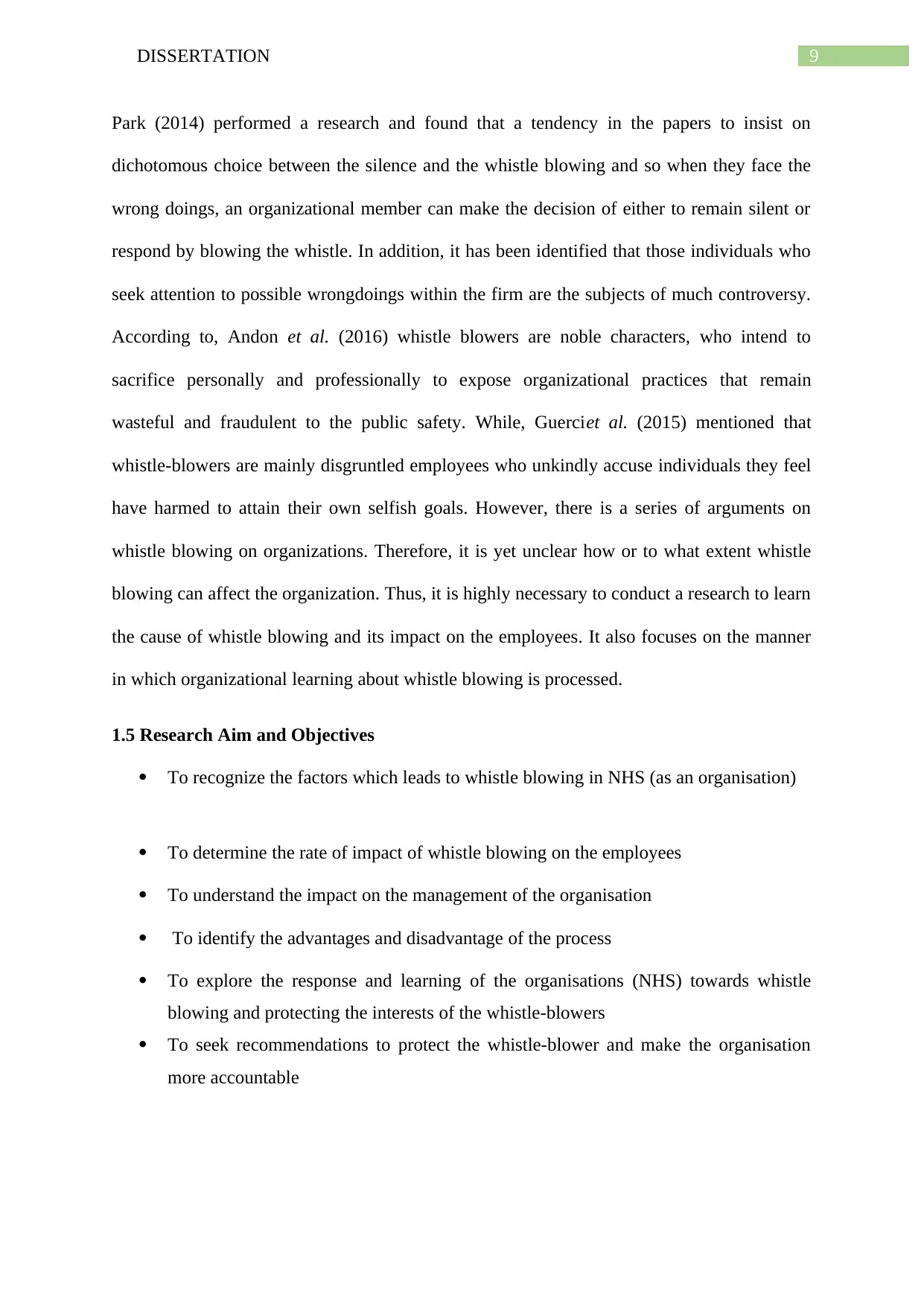
9DISSERTATION
Park (2014) performed a research and found that a tendency in the papers to insist on
dichotomous choice between the silence and the whistle blowing and so when they face the
wrong doings, an organizational member can make the decision of either to remain silent or
respond by blowing the whistle. In addition, it has been identified that those individuals who
seek attention to possible wrongdoings within the firm are the subjects of much controversy.
According to, Andon et al. (2016) whistle blowers are noble characters, who intend to
sacrifice personally and professionally to expose organizational practices that remain
wasteful and fraudulent to the public safety. While, Guerciet al. (2015) mentioned that
whistle-blowers are mainly disgruntled employees who unkindly accuse individuals they feel
have harmed to attain their own selfish goals. However, there is a series of arguments on
whistle blowing on organizations. Therefore, it is yet unclear how or to what extent whistle
blowing can affect the organization. Thus, it is highly necessary to conduct a research to learn
the cause of whistle blowing and its impact on the employees. It also focuses on the manner
in which organizational learning about whistle blowing is processed.
1.5 Research Aim and Objectives
To recognize the factors which leads to whistle blowing in NHS (as an organisation)
To determine the rate of impact of whistle blowing on the employees
To understand the impact on the management of the organisation
To identify the advantages and disadvantage of the process
To explore the response and learning of the organisations (NHS) towards whistle
blowing and protecting the interests of the whistle-blowers
To seek recommendations to protect the whistle-blower and make the organisation
more accountable
Park (2014) performed a research and found that a tendency in the papers to insist on
dichotomous choice between the silence and the whistle blowing and so when they face the
wrong doings, an organizational member can make the decision of either to remain silent or
respond by blowing the whistle. In addition, it has been identified that those individuals who
seek attention to possible wrongdoings within the firm are the subjects of much controversy.
According to, Andon et al. (2016) whistle blowers are noble characters, who intend to
sacrifice personally and professionally to expose organizational practices that remain
wasteful and fraudulent to the public safety. While, Guerciet al. (2015) mentioned that
whistle-blowers are mainly disgruntled employees who unkindly accuse individuals they feel
have harmed to attain their own selfish goals. However, there is a series of arguments on
whistle blowing on organizations. Therefore, it is yet unclear how or to what extent whistle
blowing can affect the organization. Thus, it is highly necessary to conduct a research to learn
the cause of whistle blowing and its impact on the employees. It also focuses on the manner
in which organizational learning about whistle blowing is processed.
1.5 Research Aim and Objectives
To recognize the factors which leads to whistle blowing in NHS (as an organisation)
To determine the rate of impact of whistle blowing on the employees
To understand the impact on the management of the organisation
To identify the advantages and disadvantage of the process
To explore the response and learning of the organisations (NHS) towards whistle
blowing and protecting the interests of the whistle-blowers
To seek recommendations to protect the whistle-blower and make the organisation
more accountable
Paraphrase This Document
Need a fresh take? Get an instant paraphrase of this document with our AI Paraphraser
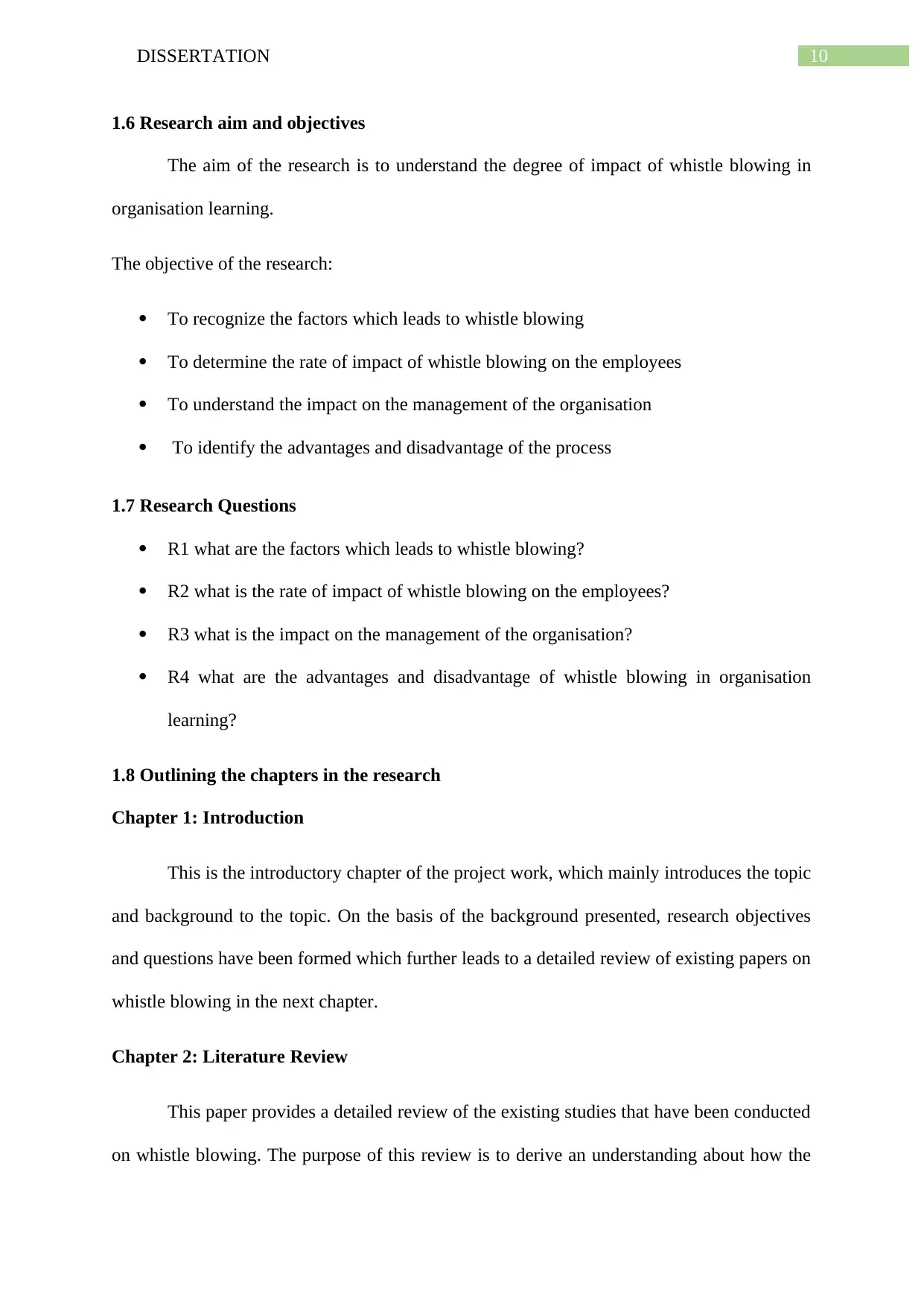
10DISSERTATION
1.6 Research aim and objectives
The aim of the research is to understand the degree of impact of whistle blowing in
organisation learning.
The objective of the research:
To recognize the factors which leads to whistle blowing
To determine the rate of impact of whistle blowing on the employees
To understand the impact on the management of the organisation
To identify the advantages and disadvantage of the process
1.7 Research Questions
R1 what are the factors which leads to whistle blowing?
R2 what is the rate of impact of whistle blowing on the employees?
R3 what is the impact on the management of the organisation?
R4 what are the advantages and disadvantage of whistle blowing in organisation
learning?
1.8 Outlining the chapters in the research
Chapter 1: Introduction
This is the introductory chapter of the project work, which mainly introduces the topic
and background to the topic. On the basis of the background presented, research objectives
and questions have been formed which further leads to a detailed review of existing papers on
whistle blowing in the next chapter.
Chapter 2: Literature Review
This paper provides a detailed review of the existing studies that have been conducted
on whistle blowing. The purpose of this review is to derive an understanding about how the
1.6 Research aim and objectives
The aim of the research is to understand the degree of impact of whistle blowing in
organisation learning.
The objective of the research:
To recognize the factors which leads to whistle blowing
To determine the rate of impact of whistle blowing on the employees
To understand the impact on the management of the organisation
To identify the advantages and disadvantage of the process
1.7 Research Questions
R1 what are the factors which leads to whistle blowing?
R2 what is the rate of impact of whistle blowing on the employees?
R3 what is the impact on the management of the organisation?
R4 what are the advantages and disadvantage of whistle blowing in organisation
learning?
1.8 Outlining the chapters in the research
Chapter 1: Introduction
This is the introductory chapter of the project work, which mainly introduces the topic
and background to the topic. On the basis of the background presented, research objectives
and questions have been formed which further leads to a detailed review of existing papers on
whistle blowing in the next chapter.
Chapter 2: Literature Review
This paper provides a detailed review of the existing studies that have been conducted
on whistle blowing. The purpose of this review is to derive an understanding about how the
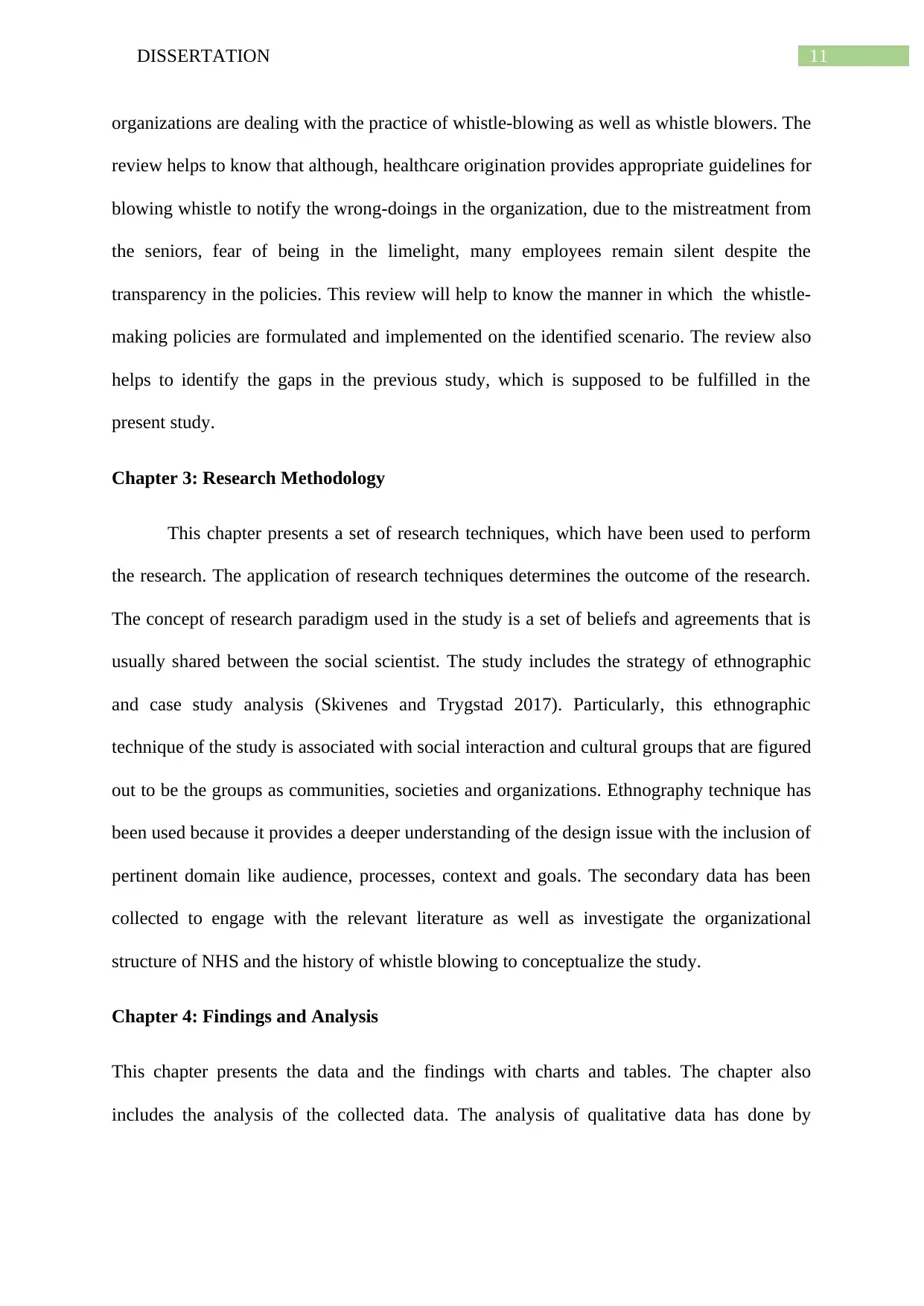
11DISSERTATION
organizations are dealing with the practice of whistle-blowing as well as whistle blowers. The
review helps to know that although, healthcare origination provides appropriate guidelines for
blowing whistle to notify the wrong-doings in the organization, due to the mistreatment from
the seniors, fear of being in the limelight, many employees remain silent despite the
transparency in the policies. This review will help to know the manner in which the whistle-
making policies are formulated and implemented on the identified scenario. The review also
helps to identify the gaps in the previous study, which is supposed to be fulfilled in the
present study.
Chapter 3: Research Methodology
This chapter presents a set of research techniques, which have been used to perform
the research. The application of research techniques determines the outcome of the research.
The concept of research paradigm used in the study is a set of beliefs and agreements that is
usually shared between the social scientist. The study includes the strategy of ethnographic
and case study analysis (Skivenes and Trygstad 2017). Particularly, this ethnographic
technique of the study is associated with social interaction and cultural groups that are figured
out to be the groups as communities, societies and organizations. Ethnography technique has
been used because it provides a deeper understanding of the design issue with the inclusion of
pertinent domain like audience, processes, context and goals. The secondary data has been
collected to engage with the relevant literature as well as investigate the organizational
structure of NHS and the history of whistle blowing to conceptualize the study.
Chapter 4: Findings and Analysis
This chapter presents the data and the findings with charts and tables. The chapter also
includes the analysis of the collected data. The analysis of qualitative data has done by
organizations are dealing with the practice of whistle-blowing as well as whistle blowers. The
review helps to know that although, healthcare origination provides appropriate guidelines for
blowing whistle to notify the wrong-doings in the organization, due to the mistreatment from
the seniors, fear of being in the limelight, many employees remain silent despite the
transparency in the policies. This review will help to know the manner in which the whistle-
making policies are formulated and implemented on the identified scenario. The review also
helps to identify the gaps in the previous study, which is supposed to be fulfilled in the
present study.
Chapter 3: Research Methodology
This chapter presents a set of research techniques, which have been used to perform
the research. The application of research techniques determines the outcome of the research.
The concept of research paradigm used in the study is a set of beliefs and agreements that is
usually shared between the social scientist. The study includes the strategy of ethnographic
and case study analysis (Skivenes and Trygstad 2017). Particularly, this ethnographic
technique of the study is associated with social interaction and cultural groups that are figured
out to be the groups as communities, societies and organizations. Ethnography technique has
been used because it provides a deeper understanding of the design issue with the inclusion of
pertinent domain like audience, processes, context and goals. The secondary data has been
collected to engage with the relevant literature as well as investigate the organizational
structure of NHS and the history of whistle blowing to conceptualize the study.
Chapter 4: Findings and Analysis
This chapter presents the data and the findings with charts and tables. The chapter also
includes the analysis of the collected data. The analysis of qualitative data has done by
⊘ This is a preview!⊘
Do you want full access?
Subscribe today to unlock all pages.

Trusted by 1+ million students worldwide
1 out of 61
Related Documents
Your All-in-One AI-Powered Toolkit for Academic Success.
+13062052269
info@desklib.com
Available 24*7 on WhatsApp / Email
![[object Object]](/_next/static/media/star-bottom.7253800d.svg)
Unlock your academic potential
Copyright © 2020–2025 A2Z Services. All Rights Reserved. Developed and managed by ZUCOL.





